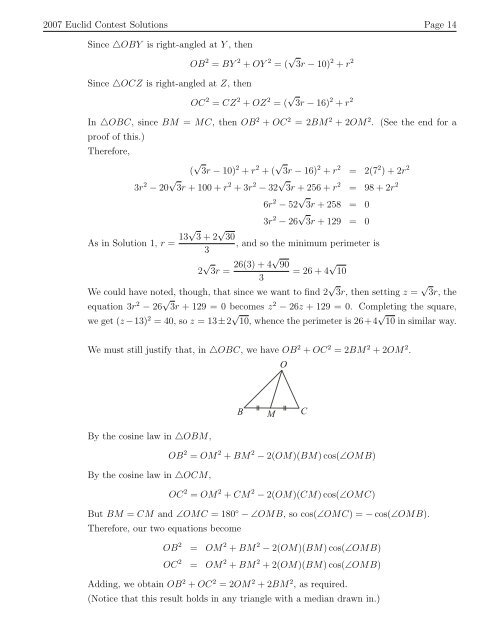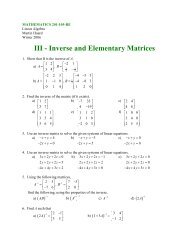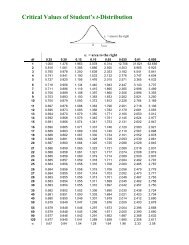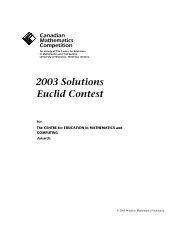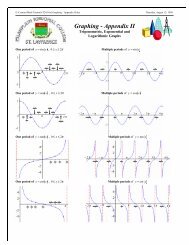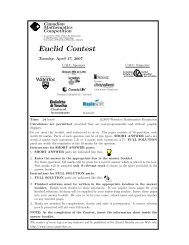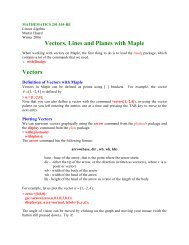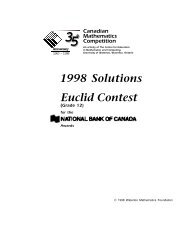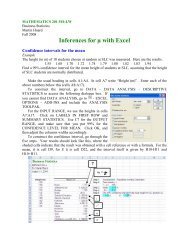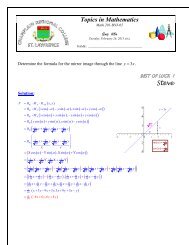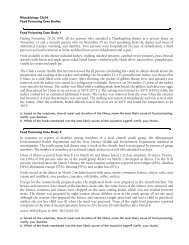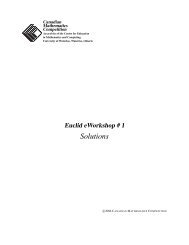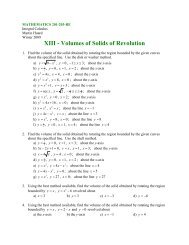Euclid Contest Solutions 2007 - CEMC - University of Waterloo
Euclid Contest Solutions 2007 - CEMC - University of Waterloo
Euclid Contest Solutions 2007 - CEMC - University of Waterloo
- No tags were found...
You also want an ePaper? Increase the reach of your titles
YUMPU automatically turns print PDFs into web optimized ePapers that Google loves.
<strong>2007</strong> <strong>Euclid</strong> <strong>Contest</strong> <strong>Solutions</strong> Page 14Since △OBY is right-angled at Y , thenSince △OCZ is right-angled at Z, thenOB 2 = BY 2 + OY 2 = ( √ 3r − 10) 2 + r 2OC 2 = CZ 2 + OZ 2 = ( √ 3r − 16) 2 + r 2In △OBC, since BM = MC, then OB 2 + OC 2 = 2BM 2 + 2OM 2 . (See the end for apro<strong>of</strong> <strong>of</strong> this.)Therefore,( √ 3r − 10) 2 + r 2 + ( √ 3r − 16) 2 + r 2 = 2(7 2 ) + 2r 23r 2 − 20 √ 3r + 100 + r 2 + 3r 2 − 32 √ 3r + 256 + r 2 = 98 + 2r 26r 2 − 52 √ 3r + 258 = 03r 2 − 26 √ 3r + 129 = 0As in Solution 1, r = 13√ 3 + 2 √ 30, and so the minimum perimeter is32 √ 3r = 26(3) + 4√ 903= 26 + 4 √ 10We could have noted, though, that since we want to find 2 √ 3r, then setting z = √ 3r, theequation 3r 2 − 26 √ 3r + 129 = 0 becomes z 2 − 26z + 129 = 0. Completing the square,we get (z −13) 2 = 40, so z = 13±2 √ 10, whence the perimeter is 26+4 √ 10 in similar way.We must still justify that, in △OBC, we have OB 2 + OC 2 = 2BM 2 + 2OM 2 .OBMCBy the cosine law in △OBM,OB 2 = OM 2 + BM 2 − 2(OM)(BM) cos(∠OMB)By the cosine law in △OCM,OC 2 = OM 2 + CM 2 − 2(OM)(CM) cos(∠OMC)But BM = CM and ∠OMC = 180 ◦ − ∠OMB, so cos(∠OMC) = − cos(∠OMB).Therefore, our two equations becomeOB 2 = OM 2 + BM 2 − 2(OM)(BM) cos(∠OMB)OC 2 = OM 2 + BM 2 + 2(OM)(BM) cos(∠OMB)Adding, we obtain OB 2 + OC 2 = 2OM 2 + 2BM 2 , as required.(Notice that this result holds in any triangle with a median drawn in.)


